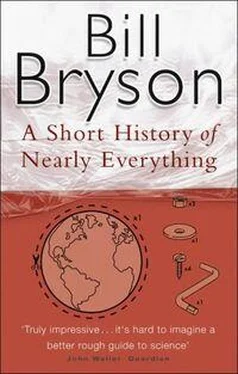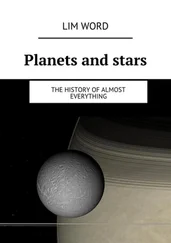But Zwicky was also capable of insights of the most startling brilliance. In the early 1930s, he turned his attention to a question that had long troubled astronomers: the appearance in the sky of occasional unexplained points of light, new stars. Improbably he wondered if the neutron-the subatomic particle that had just been discovered in England by James Chadwick, and was thus both novel and rather fashionable-might be at the heart of things. It occurred to him that if a star collapsed to the sort of densities found in the core of atoms, the result would be an unimaginably compacted core. Atoms would literally be crushed together, their electrons forced into the nucleus, forming neutrons. You would have a neutron star. Imagine a million really weighty cannonballs squeezed down to the size of a marble and-well, you’re still not even close. The core of a neutron star is so dense that a single spoonful of matter from it would weigh 200 billion pounds. A spoonful! But there was more. Zwicky realized that after the collapse of such a star there would be a huge amount of energy left over-enough to make the biggest bang in the universe. He called these resultant explosions supernovae. They would be-they are-the biggest events in creation.
On January 15, 1934, the journal Physical Review published a very concise abstract of a presentation that had been conducted by Zwicky and Baade the previous month at Stanford University. Despite its extreme brevity-one paragraph of twenty-four lines-the abstract contained an enormous amount of new science: it provided the first reference to supernovae and to neutron stars; convincingly explained their method of formation; correctly calculated the scale of their explosiveness; and, as a kind of concluding bonus, connected supernova explosions to the production of a mysterious new phenomenon called cosmic rays, which had recently been found swarming through the universe. These ideas were revolutionary to say the least. Neutron stars wouldn’t be confirmed for thirty-four years. The cosmic rays notion, though considered plausible, hasn’t been verified yet. Altogether, the abstract was, in the words of Caltech astrophysicist Kip S. Thorne, “one of the most prescient documents in the history of physics and astronomy.”
Interestingly, Zwicky had almost no understanding of why any of this would happen. According to Thorne, “he did not understand the laws of physics well enough to be able to substantiate his ideas.” Zwicky’s talent was for big ideas. Others-Baade mostly-were left to do the mathematical sweeping up.
Zwicky also was the first to recognize that there wasn’t nearly enough visible mass in the universe to hold galaxies together and that there must be some other gravitational influence-what we now call dark matter. One thing he failed to see was that if a neutron star shrank enough it would become so dense that even light couldn’t escape its immense gravitational pull. You would have a black hole. Unfortunately, Zwicky was held in such disdain by most of his colleagues that his ideas attracted almost no notice. When, five years later, the great Robert Oppenheimer turned his attention to neutron stars in a landmark paper, he made not a single reference to any of Zwicky’s work even though Zwicky had been working for years on the same problem in an office just down the hall. Zwicky’s deductions concerning dark matter wouldn’t attract serious attention for nearly four decades. We can only assume that he did a lot of pushups in this period.
Surprisingly little of the universe is visible to us when we incline our heads to the sky. Only about 6,000 stars are visible to the naked eye from Earth, and only about 2,000 can be seen from any one spot. With binoculars the number of stars you can see from a single location rises to about 50,000, and with a small two-inch telescope it leaps to 300,000. With a sixteen-inch telescope, such as Evans uses, you begin to count not in stars but in galaxies. From his deck, Evans supposes he can see between 50,000 and 100,000 galaxies, each containing tens of billions of stars. These are of course respectable numbers, but even with so much to take in, supernovae are extremely rare. A star can burn for billions of years, but it dies just once and quickly, and only a few dying stars explode. Most expire quietly, like a campfire at dawn. In a typical galaxy, consisting of a hundred billion stars, a supernova will occur on average once every two or three hundred years. Finding a supernova therefore was a little bit like standing on the observation platform of the Empire State Building with a telescope and searching windows around Manhattan in the hope of finding, let us say, someone lighting a twenty-first-birthday cake.
So when a hopeful and softspoken minister got in touch to ask if they had any usable field charts for hunting supernovae, the astronomical community thought he was out of his mind. At the time Evans had a ten-inch telescope-a very respectable size for amateur stargazing but hardly the sort of thing with which to do serious cosmology-and he was proposing to find one of the universe’s rarer phenomena. In the whole of astronomical history before Evans started looking in 1980, fewer than sixty supernovae had been found. (At the time I visited him, in August of 2001, he had just recorded his thirty-fourth visual discovery; a thirty-fifth followed three months later and a thirty-sixth in early 2003.)
Evans, however, had certain advantages. Most observers, like most people generally, are in the northern hemisphere, so he had a lot of sky largely to himself, especially at first. He also had speed and his uncanny memory. Large telescopes are cumbersome things, and much of their operational time is consumed with being maneuvered into position. Evans could swing his little sixteen-inch telescope around like a tail gunner in a dogfight, spending no more than a couple of seconds on any particular point in the sky. In consequence, he could observe perhaps four hundred galaxies in an evening while a large professional telescope would be lucky to do fifty or sixty.
Looking for supernovae is mostly a matter of not finding them. From 1980 to 1996 he averaged two discoveries a year-not a huge payoff for hundreds of nights of peering and peering. Once he found three in fifteen days, but another time he went three years without finding any at all.
“There is actually a certain value in not finding anything,” he said. “It helps cosmologists to work out the rate at which galaxies are evolving. It’s one of those rare areas where the absence of evidence is evidence.”
On a table beside the telescope were stacks of photos and papers relevant to his pursuits, and he showed me some of them now. If you have ever looked through popular astronomical publications, and at some time you must have, you will know that they are generally full of richly luminous color photos of distant nebulae and the like-fairy-lit clouds of celestial light of the most delicate and moving splendor. Evans’s working images are nothing like that. They are just blurry black-and-white photos with little points of haloed brightness. One he showed me depicted a swarm of stars with a trifling flare that I had to put close to my face to see. This, Evans told me, was a star in a constellation called Fornax from a galaxy known to astronomy as NGC1365. (NGC stands for New General Catalogue, where these things are recorded. Once it was a heavy book on someone’s desk in Dublin; today, needless to say, it’s a database.) For sixty million silent years, the light from the star’s spectacular demise traveled unceasingly through space until one night in August of 2001 it arrived at Earth in the form of a puff of radiance, the tiniest brightening, in the night sky. It was of course Robert Evans on his eucalypt-scented hillside who spotted it.
Читать дальше












